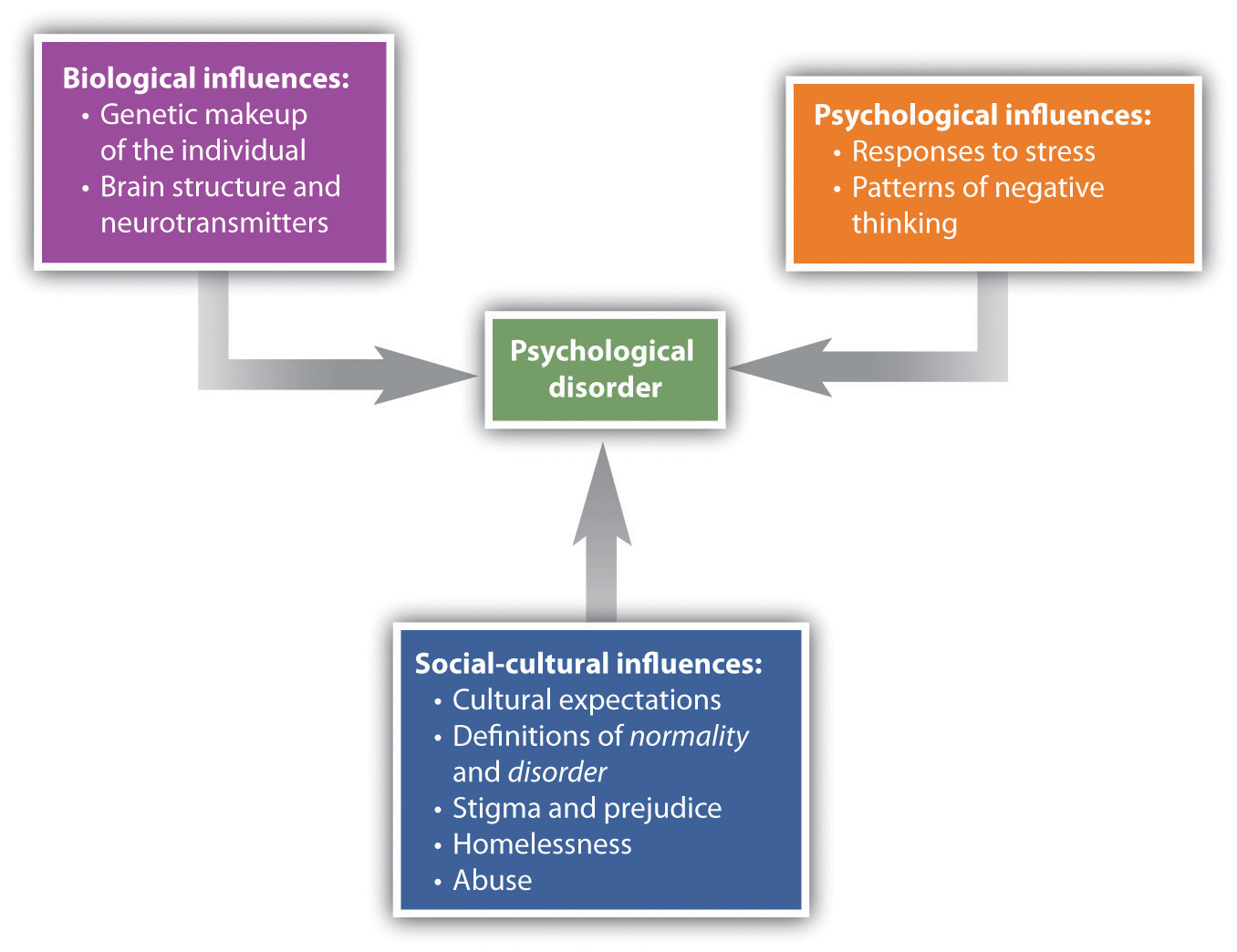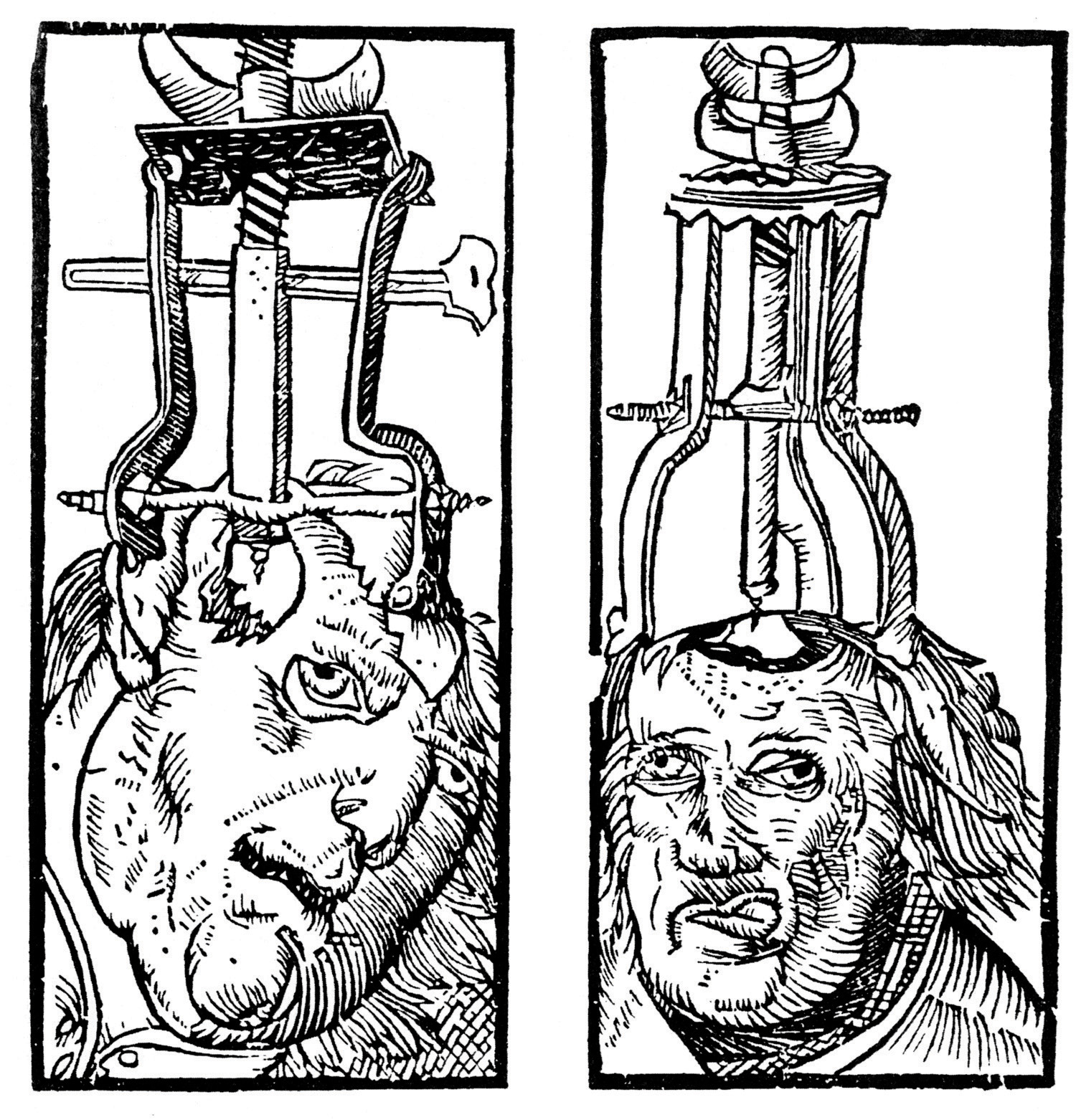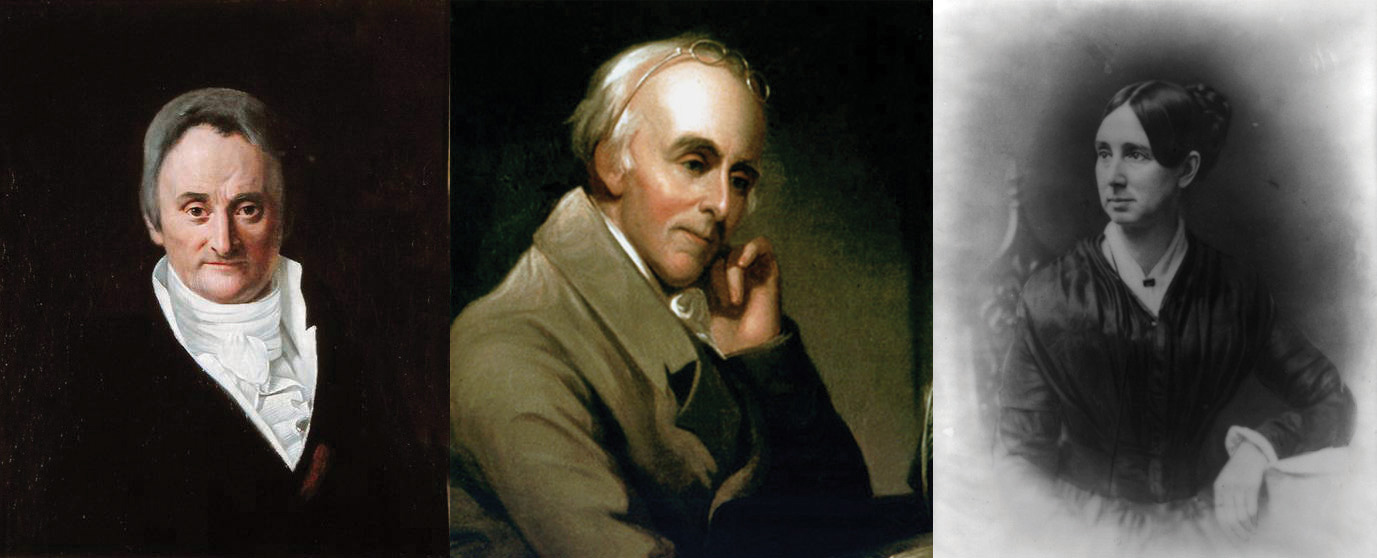13.1 Psychological Disorder: What Makes a Behaviour Abnormal?
Learning Objectives
- Define “psychological disorder” and summarize the general causes of disorder.
- Explain why it is so difficult to define disorder, and how the Diagnostic and Statistical Manual of Mental Disorders (DSM) is used to make diagnoses.
- Describe the stigma of psychological disorders and their impact on those who suffer from them.
The focus of this chapter and the next is, to many people, the heart of psychology. This emphasis on abnormal psychology — the application of psychological science to understanding and treating mental disorders — is appropriate, as more psychologists are involved in the diagnosis and treatment of psychological disorder than in any other endeavour, and these are probably the most important tasks psychologists face. In 2012, approximately 2.8 million people, or 10.1% of Canadians aged 15 and older, reported symptoms consistent with at least one of six mental or substance use disorders in the past 12 months (Pearson, Janz, & Ali, 2013). At least a half billion people are affected worldwide. The six disorders measured by the Canadian Mental Health Survey were major depressive episode, bipolar disorder, generalized anxiety disorder, and abuse of or dependence on alcohol, cannabis, or other drugs. The impact of mental illness is particularly strong on people who are poorer, of lower socioeconomic class, and from disadvantaged ethnic groups.
People with psychological disorders are also stigmatized by the people around them, resulting in shame and embarrassment, as well as prejudice and discrimination against them. Thus the understanding and treatment of psychological disorder has broad implications for the everyday life of many people. Table 13.1, “Prevalence Rates for Psychological Disorders in Canada, 2012,” shows the prevalence, the frequency of occurrence of a given condition in a population at a given time, of some of the major psychological disorders in Canada.

In this chapter our focus is on the disorders themselves. We will review the major psychological disorders and consider their causes and their impact on the people who suffer from them. Then in Chapter 14, “Treating Psychological Disorders,” we will turn to consider the treatment of these disorders through psychotherapy and drug therapy.
Defining Disorder
A psychological disorder is an ongoing dysfunctional pattern of thought, emotion, and behaviour that causes significant distress, and that is considered deviant in that person’s culture or society (Butcher, Mineka, & Hooley, 2007). Psychological disorders have much in common with other medical disorders. They are out of the patient’s control, they may in some cases be treated by drugs, and their treatment is often covered by medical insurance. Like medical problems, psychological disorders have both biological (nature) as well as environmental (nurture) influences. These causal influences are reflected in the bio-psycho-social model of illness (Engel, 1977).
The bio-psycho-social model of illness is a way of understanding disorder that assumes that disorder is caused by biological, psychological, and social factors (Figure 13.1, “The Bio-Psycho-Social Model”). The biological component of the bio-psycho-social model refers to the influences on disorder that come from the functioning of the individual’s body. Particularly important are genetic characteristics that make some people more vulnerable to a disorder than others and the influence of neurotransmitters. The psychological component of the bio-psycho-social model refers to the influences that come from the individual, such as patterns of negative thinking and stress responses. The social component of the bio-psycho-social model refers to the influences on disorder due to social and cultural factors such as socioeconomic status, homelessness, abuse, and discrimination.

To consider one example, the psychological disorder of schizophrenia has a biological cause because it is known that there are patterns of genes that make a person vulnerable to the disorder (Gejman, Sanders, & Duan, 2010). But whether or not the person with a biological vulnerability experiences the disorder depends in large part on psychological factors such as how the individual responds to the stress he or she experiences, as well as social factors such as whether or not the person is exposed to stressful environments in adolescence and whether or not the person has support from people who care about him or her (Sawa & Snyder, 2002; Walker, Kestler, Bollini, & Hochman, 2004). Similarly, mood and anxiety disorders are caused in part by genetic factors such as hormones and neurotransmitters, in part by the individual’s particular thought patterns, and in part by the ways that other people in the social environment treat the person with the disorder. We will use the bio-psycho-social model as a framework for considering the causes and treatments of disorder.
Although they share many characteristics with them, psychological disorders are nevertheless different from medical conditions in important ways. For one, diagnosis of psychological disorders can be more difficult. Although a medical doctor can see cancer in the lungs using an MRI scan or see blocked arteries in the heart using cardiac catheterization, there is no corresponding test for psychological disorder. Current research is beginning to provide more evidence about the role of brain structures in psychological disorder, but for now the brains of people with severe mental disturbances often look identical to those of people without such disturbances.
Because there are no clear biological diagnoses, psychological disorders are instead diagnosed on the basis of clinical observations of the behaviours that the individual engages in. These observations find that emotional states and behaviours operate on a continuum, ranging from more normal and accepted to more deviant, abnormal, and unaccepted. The behaviours that are associated with disorder are in many cases the same behaviours that we engage in during our normal everyday life. Washing one’s hands is a normal healthy activity, but it can be overdone by those with an obsessive-compulsive disorder (OCD). It is not unusual to worry about and try to improve one’s body image. The dancer in Figure 13.2, “How Thin Is Too Thin?” needs to be thin for her career, but when does her dieting turn into a psychological disorder? Psychologists believe this happens when the behaviour becomes distressing and dysfunctional to the person. Robert’s struggle with his personal appearance, as discussed at the beginning of this chapter, was clearly unusual, unhealthy, and distressing to him.

Whether a given behaviour is considered a psychological disorder is determined not only by whether a behaviour is unusual (e.g., whether it is mild anxiety versus extreme anxiety) but also by whether a behaviour is maladaptive — that is, the extent to which it causes distress (e.g., pain and suffering) and dysfunction (impairment in one or more important areas of functioning) to the individual (American Psychiatric Association, 2013). An intense fear of spiders, for example, would not be considered a psychological disorder unless it has a significant negative impact on the sufferer’s life, for instance by causing him or her to be unable to step outside the house. The focus on distress and dysfunction means that behaviours that are simply unusual (such as some political, religious, or sexual practices) are not classified as disorders.
Put your psychology hat on for a moment and consider the behaviours of the people listed in Table 13.2, “Diagnosing Disorder.” For each, indicate whether you think the behaviour is or is not a psychological disorder. If you’re not sure, what other information would you need to know to be more certain of your diagnosis?
| [Skip Table] | |||
| Yes | No | Need more information | Description |
|---|---|---|---|
| Jackie frequently talks to herself while she is working out her math homework. Her roommate sometimes hears her and wonders if she is okay. | |||
| Charlie believes that the noises made by cars and planes going by outside his house have secret meanings. He is convinced that he was involved in the start of a nuclear war and that the only way for him to survive is to find the answer to a difficult riddle. | |||
| Harriet gets very depressed during the winter months when the light is low. She sometimes stays in her pajamas for the whole weekend, eating chocolate and watching TV. | |||
| Frank seems to be afraid of a lot of things. He worries about driving on the highway and about severe weather that may come through his neighbourhood. But mostly he fears mice, checking under his bed frequently to see if any are present. | |||
| A worshiper speaking in “tongues” at an Evangelical church views himself as “filled” with the Holy Spirit and is considered blessed with the gift to speak the “language of angels.” | |||
A trained clinical psychologist would have checked off “need more information” for each of the examples in Table 13.2, “Diagnosing Disorder,” because although the behaviours may seem unusual, there is no clear evidence that they are distressing or dysfunctional for the person. Talking to ourselves out loud is unusual and can be a symptom of schizophrenia, but just because we do it once in a while does not mean that there is anything wrong with us. It is natural to be depressed, particularly in the long winter nights, but how severe should this depression be, and how long should it last? If the negative feelings last for an extended time and begin to lead the person to miss work or classes, then they may become symptoms of a mood disorder. It is normal to worry about things, but when does worry turn into a debilitating anxiety disorder? And what about thoughts that seem to be irrational, such as being able to speak the language of angels? Are they indicators of a severe psychological disorder, or part of a normal religious experience? Again, the answer lies in the extent to which they are (or are not) interfering with the individual’s functioning in society.
Another difficulty in diagnosing psychological disorders is that they frequently occur together. For instance, people diagnosed with anxiety disorders also often have mood disorders (Hunt, Slade, & Andrews, 2004), and people diagnosed with one personality disorder frequently suffer from other personality disorders as well. Comorbidity occurs when people who suffer from one disorder also suffer at the same time from other disorders. Because many psychological disorders are comorbid, most severe mental disorders are concentrated in a small group of people (about 6% of the population) who have more than three of them (Kessler, Chiu, Demler, & Walters, 2005).
Psychology in Everyday Life: Combating the Stigma of Abnormal Behaviour
Every culture and society has its own views on what constitutes abnormal behaviour and what causes it (Brothwell, 1981). The Old Testament Book of Samuel tells us that as a consequence of his sins, God sent King Saul an evil spirit to torment him (1 Samuel 16:14). Ancient Hindu tradition attributed psychological disorder to sorcery and witchcraft. During the Middle Ages it was believed that mental illness occurred when the body was infected by evil spirits, particularly the devil. Remedies included whipping, bloodletting, purges, and trepanation (cutting a hole in the skull, Figure 13.3) to release the demons.

Until the 18th century, the most common treatment for the mentally ill was to incarcerate them in asylums or “madhouses.” During the 18th century, however, some reformers began to oppose this brutal treatment of the mentally ill, arguing that mental illness was a medical problem that had nothing to do with evil spirits or demons. In France, one of the key reformers was Philippe Pinel (1745-1826), who believed that mental illness was caused by a combination of physical and psychological stressors, exacerbated by inhumane conditions. Pinel advocated the introduction of exercise, fresh air, and daylight for the inmates, as well as treating them gently and talking with them.
Reformers such as Phillipe Pinel (1745-1826), Dorothea Dix (1802-1887), Richard M. Bucke (1837-1902), Charles K. Clarke (1857-1924), Clifford W. Beers (1876-1943), and Clarence M. Hincks (1885-1964) were instrumental in creating mental hospitals that treated patients humanely and attempted to cure them if possible (Figure 13.5). These reformers saw mental illness as an underlying psychological disorder, which was diagnosed according to its symptoms and which could be cured through treatment.
Dr Richard Bucke was appointed superintendent of the Asylum for the Insane in Hamilton in 1876 and a year later of the asylum in London, Ontario. He believed mental illness was a failure of the human biological adaptive process. In his attempts to reform the crude treatment of mentally ill patients he abandoned the practice of pacifying the inmates with alcohol or restraining them, and inaugurated regular cultural and sports events for patients.
Dr Charles Clarke was an assistant superintendent at the Hamilton asylum in the early 1880s, and later superintendent of the asylum at Kingston, Ontario. By 1887 he had changed the asylum from a jail to a hospital and was instructing nurses and attendants in the care of the mentally ill. By 1893 he was advocating that the term “asylum” be dropped and that special hospitals be constructed for the mentally ill.
Dr Clarence Hincks, born in St Mary’s, Ontario, was interested in mental health partly due to his own experiences with severe depression. In 1918, with Beers’s help, he organized the Canadian National Committee for Mental Hygiene, which later became the Canadian Mental Health Association.
Dix was a Massachusetts schoolteacher who wrote, lectured, and informed the public and legislators about the deplorable conditions in mental institutions like those shown in Figure 13.4. She was successful in influencing a number of state legislatures either to establish or improve their mental institutions, and because of her efforts a mental hospital was built in St. John’s, Newfoundland, in 1885. She also lobbied the Nova Scotia legislature and oversaw the building of a hospital for mental patients in that province.
Phillipe Pinel was a French physician who became intensely interested in mental health in the 1770s. He took a psychological approach as opposed to the prominent biological approach that was the custom and introduced new forms of treatments that involved close contact with and careful observation of patients. Pinel visited each patient up to several times a day, engaging them in lengthy conversations, and took careful notes in an effort to assemble a detailed case history and a natural history of the patient’s illness. At the time, his therapy was quite contrary to the usual practices of bleeding, purging, or blistering.


Despite the progress made since the 1800s in public attitudes about those who suffer from psychological disorders, people, including police, coworkers, and even friends and family members, still stigmatize people with psychological disorders. A stigma refers to a disgrace or defect that indicates that person belongs to a culturally devalued social group. In some cases the stigma of mental illness is accompanied by the use of disrespectful and dehumanizing labels, including names such as crazy, nuts, mental, schizo, and retard.
The stigma of mental disorder affects people while they are ill, while they are healing, and even after they have healed (Schefer, 2003). On a community level, stigma can affect the kinds of services social service agencies give to people with mental illness, and the treatment provided to them and their families by schools, workplaces, places of worship, and health-care providers. Stigma about mental illness also leads to employment discrimination, despite the fact that with appropriate support, even people with severe psychological disorders are able to hold a job (Boardman, Grove, Perkins, & Shepherd, 2003; Leff & Warner, 2006; Ozawa & Yaeda, 2007; Pulido, Diaz, & Ramirez, 2004).
The mass media has a significant influence on society’s attitude toward mental illness (Francis, Pirkis, Dunt, & Blood, 2001). While media portrayal of mental illness is often sympathetic, negative stereotypes still remain in newspapers, magazines, film, and television. (See the following video for an  example.)
example.)
Television advertisements may perpetuate negative stereotypes about the mentally ill. For example, in 2010 Burger King ran an ad called “The King’s Gone Crazy,” in which the company’s mascot runs around an office complex carrying out acts of violence and wreaking havoc.
Watch: “Burger King: The King’s Gone Crazy” [YouTube]: http://www.youtube.com/watch?v=xYA7AnVwejo
The most significant problem of the stigmatization of those with psychological disorder is that it slows their recovery. People with mental problems internalize societal attitudes about mental illness, often becoming so embarrassed or ashamed that they conceal their difficulties and fail to seek treatment. Stigma leads to lowered self-esteem, increased isolation, and hopelessness, and it may negatively influence the individual’s family and professional life (Hayward & Bright, 1997).
Despite all of these challenges, however, many people overcome psychological disorders and go on to lead productive lives. It is up to all of us who are informed about the causes of psychological disorder and the impact of these conditions on people to understand, first, that mental illness is not a “fault” any more than is cancer. People do not choose to have a mental illness. Second, we must all work to help overcome the stigma associated with disorder. Organizations such as the Canadian Mental Health Association (CMHA) help by working to reduce the negative impact of stigma through education, community action, and individual support.
Diagnosing Disorder: The DSM
Psychologists have developed criteria that help them determine whether behaviour should be considered a psychological disorder and which of the many disorders particular behaviours indicate. These criteria are laid out in a 1,000-page manual known as the Diagnostic and Statistical Manual of Mental Disorders (DSM), a document that provides a common language and standard criteria for the classification of mental disorders (American Psychiatric Association, 2013). The DSM is used by therapists, researchers, drug companies, health insurance companies, and policymakers in Canada and the United States to determine what services are appropriately provided for treating patients with given symptoms.
The first edition of the DSM was published in 1952 on the basis of census data and psychiatric hospital statistics. Since then, the DSM has been revised five times. The last major revision was the fourth edition (DSM-IV), published in 1994, and an update of that document was produced in 2000 (DSM-IV-TR). The fifth edition (DSM-5) is the most recent edition and was published in 2013. The Medical Council of Canada transitioned to the DSM-5 recently (MCC, 2013). The DSM-IV-TR was designed in conjunction with the World Health Organization’s 10th version of the International Classification of Diseases (ICD-10), which is used as a guide for mental disorders in Europe and other parts of the world.
The DSM does not attempt to specify the exact symptoms that are required for a diagnosis. Rather, the DSM uses categories, and patients whose symptoms are similar to the description of the category are said to have that disorder. The DSM frequently uses qualifiers to indicate different levels of severity within a category. For instance, the disorder of mental retardation can be classified as mild, moderate, or severe.
Each revision of the DSM takes into consideration new knowledge as well as changes in cultural norms about disorder. Homosexuality, for example, was listed as a mental disorder in the DSM until 1973, when it was removed in response to advocacy by politically active gay rights groups and changing social norms. The current version of the DSM lists about 400 disorders.
Although the DSM has been criticized regarding the nature of its categorization system (and it is frequently revised to attempt to address these criticisms), for the fact that it tends to classify more behaviours as disorders with every revision (even “academic problems” are now listed as a potential psychological disorder), and for the fact that it is primarily focused on Western illness, it is nevertheless a comprehensive, practical, and necessary tool that provides a common language to describe disorder. Most insurance companies will not pay for therapy unless the patient has a DSM diagnosis. The DSM approach allows a systematic assessment of the patient, taking into account the mental disorder in question, the patient’s medical condition, psychological and cultural factors, and the way the patient functions in everyday life.
Diagnosis or Overdiagnosis? ADHD, Autistic Disorder, and Asperger’s Disorder
Two common critiques of the DSM are that the categorization system leaves quite a bit of ambiguity in diagnosis and that it covers such a wide variety of behaviours. Let’s take a closer look at three common disorders — attention-deficit/hyperactivity disorder (ADHD), autistic disorder, and Asperger’s disorder — that have recently raised controversy because they are being diagnosed significantly more frequently than they were in the past.
Attention-Deficit/Hyperactivity Disorder (ADHD)
Zack, aged seven years, has always had trouble settling down. He is easily bored and distracted. In school, he cannot stay in his seat for very long and he frequently does not follow instructions. He is constantly fidgeting or staring into space. Zack has poor social skills and may overreact when someone accidentally bumps into him or uses one of his toys. At home, he chatters constantly and rarely settles down to do a quiet activity, such as reading a book.
Symptoms such as Zack’s are common among seven-year-olds, and particularly among boys. But what do the symptoms mean? Does Zack simply have a lot of energy and a short attention span? Boys mature more slowly than girls at this age, and perhaps Zack will catch up in the next few years. One possibility is for the parents and teachers to work with Zack to help him be more attentive, to put up with the behaviour, and to wait it out.
But many parents, often on the advice of the child’s teacher, take their children to a psychologist for diagnosis. If Zack were taken for testing today, it is very likely that he would be diagnosed with a psychological disorder known as attention-deficit/hyperactivity disorder (ADHD). ADHD is a developmental behaviour disorder characterized by problems with focus, difficulty maintaining attention, and inability to concentrate, in which symptoms start before seven years of age (Canadian Mental Health Association, 2014). Although it is usually first diagnosed in childhood, ADHD can remain problematic in adults, and up to 7% of university students are diagnosed with it (Weyandt & DuPaul, 2006). In adults the symptoms of ADHD include forgetfulness, difficulty paying attention to details, procrastination, disorganized work habits, and not listening to others. ADHD is about 70% more likely to occur in males than in females (Kessler, Chiu, Demler, & Walters, 2005), and is often comorbid with other behavioural and conduct disorders.
The diagnosis of ADHD has quadrupled over the past 20 years, and it is now diagnosed in about one out of every 37 Canadian children. It is the most common psychological disorder among children in the world (Olfson, Gameroff, Marcus, & Jensen, 2003). ADHD is also being diagnosed much more frequently in adolescents and adults (Barkley, 1998). You might wonder what this all means. Are the increases in the diagnosis of ADHD because today’s children and adolescents are actually more distracted and hyperactive than their parents were, due to a greater awareness of ADHD among teachers and parents, or due to psychologists and psychiatrists’ tendency to overdiagnose the problem? Perhaps drug companies are also involved, because ADHD is often treated with prescription medications, including stimulants such as Ritalin.
Although skeptics argue that ADHD is overdiagnosed and is a handy excuse for behavioural problems, most psychologists believe that ADHD is a real disorder that is caused by a combination of genetic and environmental factors. Twin studies have found that ADHD is heritable (National Institute of Mental Health, 2010), and neuroimaging studies have found that people with ADHD may have structural differences in areas of the brain that influence self-control and attention (Seidman, Valera, & Makris, 2005). Other studies have also pointed to environmental factors, such as a mother’s smoking and drinking alcohol during pregnancy and the consumption of lead and food additives by those who are affected (Braun, Kahn, Froehlich, Auinger, & Lanphear, 2006; Linnet et al., 2003; McCann et al., 2007). Social factors, such as family stress and poverty, also contribute to ADHD (Burt, Krueger, McGue, & Iacono, 2001).
Autistic Disorder and Asperger’s Disorder
Jared’s kindergarten teacher has voiced her concern to Jared’s parents about his difficulties with interacting with other children and his delay in developing normal language. Jared is able to maintain eye contact and enjoys mixing with other children, but he cannot communicate with them very well. He often responds to questions or comments with long-winded speeches about trucks or some other topic that interests him, and he seems to lack awareness of other children’s wishes and needs.
Jared’s concerned parents took him to a multidisciplinary child development centre for consultation. Here he was tested by a pediatric neurologist, a psychologist, and a child psychiatrist.
The pediatric neurologist found that Jared’s hearing was normal, and there were no signs of any neurological disorder. He diagnosed Jared with a pervasive developmental disorder, because while his comprehension and expressive language was poor, he was still able to carry out nonverbal tasks, such as drawing a picture or doing a puzzle.
Based on her observation of Jared’s difficulty interacting with his peers, and the fact that he did not respond warmly to his parents, the psychologist diagnosed Jared with autistic disorder (autism), a disorder of neural development characterized by impaired social interaction and communication and by restricted and repetitive behaviour, and in which symptoms begin before seven years of age. The psychologist believed that the autism diagnosis was correct because, like other children with autism, Jared, has a poorly developed ability to see the world from the perspective of others, engages in unusual behaviours such as talking about trucks for hours, and responds to stimuli, such as the sound of a car or an airplane, in unusual ways.
The child psychiatrist believed that Jared’s language problems and social skills were not severe enough to warrant a diagnosis of autistic disorder and instead proposed a diagnosis of Asperger’s disorder, a developmental disorder that affects a child’s ability to socialize and communicate effectively with others and in which symptoms begin before seven years of age. The symptoms of Asperger’s are almost identical to that of autism (with the exception of a delay in language development), and the child psychiatrist simply saw these problems as less extreme.
Imagine how Jared’s parents must have felt at this point. Clearly there is something wrong with their child, but even the experts cannot agree on exactly what the problem is. Diagnosing problems such as Jared’s is difficult, yet the number of children like him is increasing dramatically. Disorders related to autism and Asperger’s disorder now affect 0.68% of Canadian children (Statistics Canada, 2003). The milder forms of autism, and particularly Asperger’s, have accounted for most of this increase in diagnosis.
Although for many years autism was thought to be primarily a socially determined disorder, in which parents who were cold, distant, and rejecting created the problem, current research suggests that biological factors are most important. The heritability of autism has been estimated to be as high as 90% (Freitag, 2007). Scientists speculate that autism is caused by an unknown genetically determined brain abnormality that occurs early in development. It is likely that several different brain sites are affected (Moldin, 2003), and the search for these areas is being conducted in many scientific laboratories.
But does Jared have autism or Asperger’s? The problem is that diagnosis is not exact (remember the idea of categories), and the experts themselves are often unsure how to classify behaviour. Furthermore, the appropriate classifications change with time and new knowledge. Under the DSM-5, released on May 18, 2013, Asperger’s Syndrome is now subsumed under the category of Autism Spectrum Disorder (ASD).
Key Takeaways
- More psychologists are involved in the diagnosis and treatment of psychological disorder than in any other endeavour, and those tasks are probably the most important psychologists face.
- The impact on people with a psychological disorder comes both from the disease itself and from the stigma associated with disorder.
- A psychological disorder is an ongoing dysfunctional pattern of thought, emotion, and behaviour that causes significant distress and that is considered deviant in that person’s culture or society.
- According to the bio-psycho-social model, psychological disorders have biological, psychological, and social causes.
- It is difficult to diagnose psychological disorders, although the DSM provides guidelines that are based on a category system. The DSM is frequently revised, taking into consideration new knowledge as well as changes in cultural norms about disorder.
- There is controversy about the diagnosis of disorders such as ADHD, autistic disorder, and Asperger’s disorder.
Exercises and Critical Thinking
- Do you or your friends hold stereotypes about the mentally ill? Can you think of or find clips from any films or other popular media that portray mental illness positively or negatively? Is it more or less acceptable to stereotype the mentally ill than to stereotype other social groups?
- Consider the diagnosis of ADHD, autism, and Asperger’s disorder from the biological, personal, and social-cultural perspectives. Do you think that these disorders are overdiagnosed? How might clinicians determine if ADHD is dysfunctional or distressing to the individual?
References
American Psychiatric Association. (2013). Diagnostic and Statistical Manual of Mental Disorders, Fifth Edition. Arlington, VA: American Psychiatric Association.
Barkley, R. A. (1998). Attention-deficit hyperactivity disorder: A handbook for diagnosis and treatment (2nd ed.). New York, NY: Guilford Press.
Boardman, J., Grove, B., Perkins, R., & Shepherd, G. (2003). Work and employment for people with psychiatric disabilities. British Journal of Psychiatry, 182(6), 467–468.
Braun, J., Kahn, R., Froehlich, T., Auinger, P., & Lanphear, B. (2006). Exposures to environmental toxicants and attention-deficit/hyperactivity disorder in U.S. children. Environmental Health Perspectives, 114(12), 1904–1909.
Brothwell, D. (1981). Digging up bones: The excavation, treatment, and study of human skeletal remains. Ithaca, NY: Cornell University Press.
Burt, S. A., Krueger, R. F., McGue, M., & Iacono, W. G. (2001). Sources of covariation among attention-deficit/hyperactivity disorder, oppositional defiant disorder, and conduct disorder: The importance of shared environment. Journal of Abnormal Psychology, 110(4), 516–525.
Butcher, J., Mineka, S., & Hooley, J. (2007). Abnormal psychology and modern life (13th ed.). Boston, MA: Allyn & Bacon.
Canadian Mental Health Association. (2014). Understanding mental illness: Attention deficit disorder. Retrieved May 2014 from http://www.cmha.ca/mental-health/understanding-mental-illness/attention-deficit-disorders/
Engel, G. (1977). The need for a new medical model: A challenge for biomedicine. Science, 196(4286), 129.
Francis, C., Pirkis, J., Dunt, D., & Blood, R. (2001). Mental health and illness in the media: A review of the literature. Canberra, Australia: Commonwealth Department of Health & Aged Care.
Freitag C. M. (2007). The genetics of autistic disorders and its clinical relevance: A review of the literature. Molecular Psychiatry, 12(1), 2–22.
Gejman, P., Sanders, A., & Duan, J. (2010). The role of genetics in the etiology of schizophrenia. Psychiatric Clinics of North America, 33(1), 35–66.
Hayward, P., & Bright, J. (1997). Stigma and mental illness: A review and critique. Journal of Mental Health, 6(4), 345–354.
Hunt, C., Slade, T., & Andrews, G. (2004). Generalized anxiety disorder and major depressive disorder comorbidity in the National Survey of Mental Health and Well Being. Depression and Anxiety, 20, 23–31.
Kessler, R. C., Chiu, W. T., Demler, O., & Walters, E. E. (2005). Prevalence, severity, and comorbidity of 12-month DSM-IV disorders in the National Comorbidity Survey Replication. Archives of General Psychiatry, 62(6), 617–627.
Leff, J., & Warner, R. (2006). Social inclusion of people with mental illness. New York, NY: Cambridge University Press.
Linnet K., Dalsgaard, S., Obel, C., Wisborg, K., Henriksen T., Rodriguez, A.,…Jarvelin, M. (2003). Maternal lifestyle factors in pregnancy risk of attention-deficit/hyperactivity disorder and associated behaviors: Review of the current evidence. American Journal of Psychiatry, 160(6), 1028–1040.
McCann, D., Barrett, A., Cooper, A., Crumpler, D., Dalen, L., Grimshaw, K.,…Stevenson, J. (2007). Food additives and hyperactive behaviour in 3-year-old and 8/9-year-old children in the community: A randomised, double-blinded, placebo-controlled trial. Lancet, 370(9598), 1560–1567.
Medical Council of Canada. (2013). Medical Council of Canada transition to DSM-5. Retrieved May 2014 from http://mcc.ca/2014/01/transition-to-dsm-5/
Moldin, S. O. (2003). Editorial: Neurobiology of autism: The new frontier. Genes, Brain & Behavior, 2(5), 253–254.
National Institute of Mental Health. (2010). Attention-deficit hyperactivity disorder (ADHD). Retrieved from http://www.nimh.nih.gov/health/topics/attention-deficit-hyperactivity-disorder-adhd/index.shtml
Olfson, M., Gameroff, M., Marcus, S., & Jensen, P. (2003). National trends in the treatment of attention deficit hyperactivity disorder. American Journal of Psychiatry, 160, 1071–1077.
Ozawa, A., & Yaeda, J. (2007). Employer attitudes toward employing persons with psychiatric disability in Japan. Journal of Vocational Rehabilitation, 26(2), 105–113.
Pearson, C., Janz, T., & Ali, J. (2013). Mental and substance use disorders in Canada: Health at a Glance. Statistics Canada, Catalogue no. 82-624-X.
Pulido, F., Diaz, M., & Ramírez, M. (2004). Work integration of people with severe mental disorder: A pending question. Revista Psiquis, 25(6), 26–43.
Sawa, A., & Snyder, S. (2002). Schizophrenia: Diverse approaches to a complex disease. Science, 296(5568), 692–695.
Schefer, R. (2003, May 28). Addressing stigma: Increasing public understanding of mental illness [PDF]. Presented to the Standing Senate Committee on Social Affairs, Science and Technology. Retrieved from http://www.camh.net/education/Resources_communities_organizations/addressing_stigma_senatepres03.pdf
Seidman, L., Valera, E., & Makris, N. (2005). Structural brain imaging of attention deficit/hyperactivity disorder. Biological Psychiatry, 57, 1263–1272.
Statistics Canada. (2003). Canadian Community Health Survey 2003; numbers compiled for the Library of Parliament. Retrieved May 2014 from http://www.parl.gc.ca/Content/LOP/ResearchPublications/prb0593-e.htm#footnote8
Statistics Canada. (2013). Health at a Glance: Mental and substance use disorders in Canada [PDF]; Catalogue no.82-624-X, Health Statistics Canada. Retrieved July 2014 from http://www.statcan.gc.ca/pub/82-624-x/2013001/article/11855-eng.pdf
Weyandt, L. L., & DuPaul, G. (2006). ADHD in college students. Journal of Attention Disorders, 10(1), 9–19.
Image Attributions
Figure 13.1: “beautiful-dancer-by-aisha-mitchell” by Gerard Van der Leun is licensed under CC BY-NC-ND 2.0 license (http://creativecommons.org/licenses/by-nc-nd/2.0/deed.en_CA).
Figure 13.3: Engraving of a trepanation by Peter Treveris (http://commons.wikimedia.org/wiki/File:Peter_Treveris_-_ engraving_of_Trepanation_for_Handywarke_of_surgeri_1525.png) is in public domain.
Figure 13.4: Sheriff Hill Lunatic Asylum by U.S. Library of Congress, (http://commons.wikimedia.org/wiki/File:Sheriff_Hill_Lunatic_Asylum.jpg) is in the public domain.
Figure 13.5: Philippe Pinel portrait by Anna Mérimée (http://commons.wikimedia.org/wiki/File:Philippe_Pinel_%281745_-_1826%29.jpg) is in the public domain. Benjamin Rush Painting by Charles Wilson Peale (http://commons.wikimedia.org/wiki/File:Benjamin_Rush_Painting_by_Peale.jpg) is in the public domain. Dix Dorothea portrait by U.S. Library of Congress, (http://commons.wikimedia.org/wiki/File:Dix-Dorothea-LOC.jpg) is in the public domain.
Long Descriptions
| Disorder | Lifetime | 12-month | |
|---|---|---|---|
| Substance use disorder | Alcohol abuse or dependence | 18.1% | 3.2% |
| Cannabis abuse or dependence | 6.8% | 1.3% | |
| Other drug abuse or dependence (excluding Cannabis) | 4% | 0.7% | |
| Total substance use disorders | 21.6% | 4.4% | |
| Mood Disorder | Major Depressive Episode | 11.3% | 4.7% |
| Bipolar disorder | 2.6% | 1.5% | |
| Generalized anxiety disorder | 8.7% | 2.6% | |
| Total mood disorders | 12.6% | 5.4% | |
| Total Mental/Substance disorders | 33.1% | 10.1% | |

